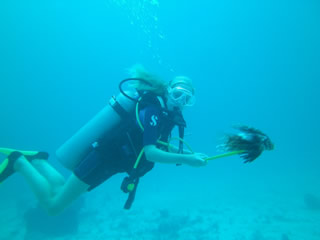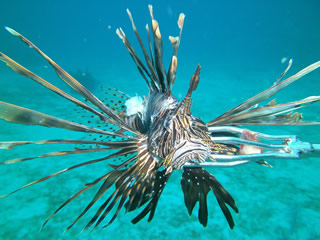Combat & Eat Lionfish
Lionfish are causing so much harm that they may actually cause the complete collapse of many fisheries and reefs
“They are what scientists call a near-perfect invader.”
Studies have shown that they can stuff 50 or 60 baby fish into their stomachs.
They can grow to 20 inches long, can even live at 1000ft deep and even in estuarine environments over 4 miles inland
A female lionfish can release between 10,000 & 30,000 unfertilized eggs every 4 days year around, approx. 2 MILLION eggs per year.
That studies have shown that lionfish can live without food for up to 3 months and only lose 10% of their body mass.
Research has shown that just one Lionfish can reduce marine creatures by 80% - 90% within its range in 5 weeks.
Why eat the Lionfish? Source: http://www.lionfish.co
They are healthier than eating snapper or grouper because lionfish have higher concentration of heart healthy omega-3 fatty acids, scoring above snapper and grouper as well as tilapia, Bluefin tuna, mahi mahi, wahoo and other table-fish commonly served in restaurants. Lionfish are also very low in heavy metals like mercury and lead!
Lionfish are not poisonous, they are venomous.
The difference between poison and venom is the method of delivery. Venom must be injected into the bloodstream to cause injury, such as through a sharp spine or fang, but is harmless if drunk or eaten. Poison has to be ingested or absorbed to be harmful; lionfish carry no poison in the edible meat of the fish.
Scuba Diving is more than a $2billion economy for the Caribbean Islands.
The Islands hotels, dive centers, fishing charters, restaurants and all their employees in these throughout the Caribbean rely upon a continuous stream of tourists looking for the best first time, recreational and sport experiences.
If these reefs die with the spectacular fish species gone, scuba divers will sadly choose a better destination. When the sport fish stocks are no more, the sport fishermen will stop visiting, too. Local peoples income will decline rapidly, jobs are gone and the Islands key industry and economy collapses.


 She added that any Lionfish management plans developed should include the three pillars – environmental, social and economic. Dr. Inniss explained that in addition to reducing the Lionfish population and protecting and conserving the island’s coral reefs, it was important to consider it as a way of improving the island’s food security.
She added that any Lionfish management plans developed should include the three pillars – environmental, social and economic. Dr. Inniss explained that in addition to reducing the Lionfish population and protecting and conserving the island’s coral reefs, it was important to consider it as a way of improving the island’s food security.